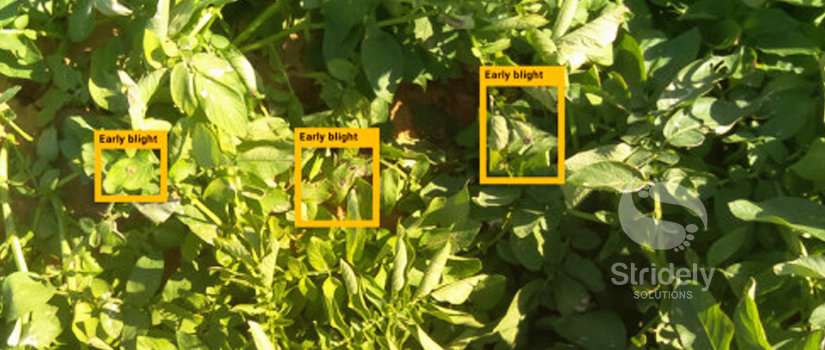Weeds are a major factor that affects the quality and quantity of agricultural produce. Generally, chemical herbicide sprays are used for eliminating weeds from the farmland. But its continuous use adds waste and pollution to the ecological environment of the farmland.
Over the years, the level of agricultural production has been improved. Plus, the improved methods have also helps in distinguishing weed from crops accurately. Thanks to the computer vision technology that helps in successful weeds detection. It allows the individuals to ensure that the spray is used only for weeds. However, it is to be noted that accurate spraying is dependent on accurately identification of crops and weeds.
Business Solution: Smart Product Recommendation System
The use of computer vision technology in weed detection has increased considerably in the recent years. It uses two data science methods: deep learning and image processing for solving weed detection issues. With this technology in use users can get overview of a number of methods that can be used to detect weed and provide weed datasets.
Agricultural Herbicide Spraying and Weed Detection using Smart Computer Vision
Using herbicides in the initial stages increases the yield while reducing the waiting time needed for growth of the crop. The procedures for eradicating and controlling the weed existing in land needed manual efforts. A more efficient alternative technique is required for reducing the man power. It will create a number of opportunities for facing the challenges of the world market.
Concept of monitor vision for weed detection ensures proper identification of weed. Plus, the technology also helps in ensuring that the herbicide isn’t sprayed to the areas where it isn’t required as the chemical contaminates both soil and water. The computer vision comprises of two techniques wavelet based algorithm and image processing for classifying the weeds.
Besides, the technique also comes in handy for segregating the weeds from the cultivated plants. It can also be used for evaluating nutrition of the soil. Additionally, it can also be used for spraying herbicide to the right area soil pollution and water contamination levels can be lowered to maximum possible extent.
Factors affecting weed detection
Weeds have complex natural properties with a number of varieties of species, random growth, leaf sizes, and shapes, and texture features. When they are in buds stage the plant size is small but their germination density is high. Resultantly, it’s difficult to get accurate data and statistics of the weed even with an efficient technology like monitor vision.
Following are major factors that affect weed detection performance –
- The growth stages of weeds – The leaf texture, spectral characteristics, and morphology of most of the weed plants change with change in the season. Hence, the development and growth stages affect weed detection process.
- Change in light conditions – It plays a major influence in weed detection as the plant canopy’s shade and the sun’s angle affects the vegetation’s color. Most of the people use Otsu algorithm and ultra-green index for solving this issue which is caused due to ambient light. Even HIS color model and grayscale images are used with the H component to reduce impact of uneven lighting on color images.
- Occlusion and overlapping leaves influence – Separating the weed plants accurately is a tough task. The overlapping leaves, field images, shadows, occlusions, damaged leaves, and leaf dead leaves affect the leaf segmentation process impossible when the computer vision processes the images.
- Weed detection bottleneck – Factors like algorithm complexity, plant density, and hardware, limit the accuracy and speed of weed detection. Hence, quick and accurate weed identification and image processing remains highly challenging task.
Use of weeding machinery in monitor vision technology
The monitor vision technology detects the smart weeds smartly which helps in identifying the target efficiently when spraying. It features autonomous robots which improve the efficiency and accuracy of the entire weeding process.
Powerful mechanical techniques and computer vision design a number of automated weed controlling robots. It leverages computer vision for detecting weeds and crops and applies the herbicides selectively. To achieve precision agriculture the weeds are eliminated or detected among rows.
It also features weed knife control system comprising of computer vision-based geometric 3D detection algorithm. The mechanical knives devices also help in automatic weed control in case of selective crops like lettuce and tomato, hence making it an ideal solution for farmland with high-weed density. It is mainly used for detecting a particular plant or weed on the field which may cause quality, health, and yield problems if consumed by livestock.
Also Read: Natural Language Processing for Manufacturing Industry
The design and functioning of a robot platform plays a crucial role in implementation of the computer vision weed detection method. Generally, a weeding device is installed in the tractor, and a camera is installed in the weeding tool. Individuals can replace the weeding tool with steam nozzles or insecticide. Smart weeding equipment and machines are more efficient and save more manpower in comparison to the traditional methods. Plus, they also enhance the overall productivity and helps individuals to achieve better results in their agricultural processes.
Limitations of weed detection through computer vision
- Different weed and crop species create different problems for species detection. The task become even more challenging when the crop and weeds present in the field have a number of similarities.
However, there have been researches for differentiating weed and crop species using robotic vision but it has helps in identification and classification of the leaves for particular plant varieties instead of the field images. The stability and accuracy is low when the method is applied for detecting weed in a vast field. - Weed detection evaluation and dataset indicators – Currently, there are a limited number of public datasets for weed detection. However, there are self-built datasets that are used to map the performance of the technology and the process. Though there are datasets for selected crops but the algorithm portability but it is difficult to measure the performance accurately.
Future of monitor Vision based weed detection in agriculture
Unlike the traditional methods, robotic vision based weed detection technique features deep learning which is based on high-end weed detection. Automatic weeding and weed detection have been achieved with the help of various mechanical equipment and methods. They have laid an excellent foundation to achieve precise weeding and high efficiency in the future. So, AI is not just changing how digital businesses work, but farming too.
Researchers have successfully obtained satisfactory results in different weed detection backgrounds; however, there is still lack of robustness and generality. Methods based on deep learning show that the technique has been successful in meeting the weed detection requirements, but most of the labeled samples also show that there is much to be done for reducing the manual working involved in the weeding process. In comparison to the weeds, it is easy to obtain the images of crop present in the field.
Efficient use of weed detection technology and developing an automatic guidance system for agricultural operations and crop detection can be conducted in a number of aspects, like spraying, harvest, transportation, and weeding.
Agricultural vehicles with automated systems don’t reduce and fatigue the operator’s labor intensity. Hence, it improves the safety and efficiency of the entire process. Currently, few devices and methods meet practical applications of weed detection requirements. However, there is a lot to be done for developing weed detection equipment with cost efficiency and high performance.
Let’s get in touch to know more.






